Active ingredients: Calcipotriol
Daivonex 50 micrograms / ml cutaneous solution
Indications Why is Daivonex used? What is it for?
Daivonex belongs to a group of medicines called anti-psoriasis. It is a type of vitamin D. Vitamin D controls the growth of skin cells.
If your skin cells grow too fast, psoriasis can develop. Psoriasis is a disease in which the skin develops thick red plaques and plaques with silver-colored scales. These scaly plaques are made up of dead cells that normally peel off the skin without people noticing.
Daivonex works by reducing the amount of cells produced by the skin. This means that skin symptoms are also reduced.
Daivonex is used to treat:
- scalp psoriasis (psoriasis on the head) of mild to moderate severity
Contraindications When Daivonex should not be used
Do not use Daivonex
- If you are allergic (hypersensitive) to calcipotriol or any of the other ingredients of the medicine. You will find the full list of excipients in section 6 of this leaflet
- If you have been told by your doctor that you have high or low levels of a substance called calcium in your body (calcium metabolism disorders)
- If you have severe kidney problems
- If you have severe liver problems
Precautions for use What you need to know before taking Daivonex
Take special care with Daivonex
Before using Daivonex, tell your doctor:
- if you are already using ultraviolet (UV) treatment. You should discuss with your doctor the possibility of undergoing UV lamp treatment in conjunction with the use of Daivonex.
Do not use Daivonex on the face.
Your doctor may tell you to limit your exposure to sunlight or artificial light while you are using this medicine.
You may have too high levels of calcium in your blood while using this medicine. Read section 4 of this leaflet so you can recognize the signs. Your doctor may find it necessary to change your dosage.
If you use the prescribed dose it is unlikely that your blood calcium levels will rise too high. You can find the advice on the dose to be used in section 3 of this leaflet. Your blood calcium levels are more likely to get too high if you use more than the recommended dose each week.
Interactions Which drugs or foods may change the effect of Daivonex
Tell your doctor or pharmacist if you are taking or have recently taken any other medicines, including medicines obtained without a prescription.
Warnings It is important to know that:
Pregnancy and breastfeeding
Ask your doctor or pharmacist for advice before using Daivonex:
- if you are pregnant or think you are
- if you are breastfeeding
Tell your doctor if you become pregnant while taking this medicine.
Driving and using machines
Usually the medicine may have minimal effects on the ability to drive or use machines. Consult your doctor if you experience any side effects that may prevent you from driving or using machines.
Important information about some of the ingredients of Daivonex
Daivonex contains:
- propylene glycol, which can cause skin irritation.
Check with your doctor if you are concerned about any of the other ingredients of this medicine.
Dose, Method and Time of Administration How to use Daivonex: Posology
Always use Daivonex exactly as your doctor has told you. Treatment should normally not be longer than 22 weeks. If in doubt, consult your doctor or pharmacist.
How to apply Daivonex
This medicine is only used on the head (scalp).
Never apply it to your face, as it can cause irritation. Do not ingest it. Do not take it in any way.
Do not mix Daivonex with other medicines.
Always wash your hands before using Daivonex.
Apply the medicine when your hair is dry. Divide your hair into zones before using the medicine. This will allow the medicine to reach the skin surface of the head better.
Tilt your head back to prevent the medicine from getting onto your face or eyes.
Bring the spout of the bottle close to your head. You can squeeze the bottle by applying the skin solution directly to the irritated area. One or two drops cover an area the size of a postage stamp. Rub gently.
Let the medicine dry on its own, it won't take long. Never dry it with a hair dryer or near a fire. Leave the medicine applied until the next hair wash. This will work better.
Always wash your hands after using Daivonex. This will prevent the medicine from accidentally spreading to other parts of the body. Don't worry if you accidentally get some medicine on your healthy skin, but wash it off if it spreads too much.
If the medicine accidentally gets in your eyes, wash it off immediately with water. Then, if possible, use an eye wash product. If your eye is sore, go to your doctor.
Keep the medicine away from glasses or plastic.
How much Daivonex to use
Your doctor will tell you how much Daivonex to use. You must apply the medicine twice a day, in the morning and in the evening. To remember to apply the medicine, it may be helpful to apply it in conjunction with another "daily action, such as brushing your teeth."
Adults:
the dosage depends on the severity of the psoriasis. Your doctor will prescribe the correct dose for you.
- If you are using this medicine alone Do not use more than 60 milliliters (ml) per week
- If you use this medicine together with other creams or ointments
Talk to your doctor or pharmacist if you are taking other medicines and are not sure what they contain.
Remember: the medicine contains an active substance called calcipotriol. You can use it together with other creams or ointments that contain calcipotriol, but you must be very careful about using these medicines at the same time, so as not to use too much in a week.
1st possibility:
Do not use more than 60 milliliters (ml) of Daivonex cutaneous solution and 30 grams of calcipotriol cream or ointment per week
2nd possibility:
Do not use more than 30 milliliters (ml) of Daivonex cutaneous solution and 60 grams of calcipotriol cream or ointment per week
Children
This drug is not recommended for use in children.
If you forget to use Daivonex
If you forget to apply the medicine, apply it as soon as you remember. Then, apply the next treatment at the usual time.
If you have any further questions on the use of this medicine, ask your doctor or pharmacist.
Overdose What to do if you have taken too much Daivonex
If you use more Daivonex than you should tell your doctor immediately.
The level of calcium in the blood can get too high. Read section 4 of this leaflet so you can recognize the signs.
Side Effects What are the side effects of Daivonex
Like all medicines, Daivonex can cause side effects, although not everybody gets them.
Important side effects to watch out for:
Get urgent medical help if you experience any of the following symptoms.
You can have an allergic reaction:
- difficulty in breathing
- swelling of the face including around the eyes
- severe skin rash.
Tell your doctor right away if you recognize any of the following signs that may be due to increased blood calcium levels:
- need to urinate more often than usual
- sense of thirst
- dry mouth or metallic taste in the mouth
- weakness or pain in the muscles or bones
- headache
- tiredness or constipation.
Other possible side effects
The possible side effects described in the following section of this leaflet are generally mild.
Very common side effects (likely to affect more than 1 in 10 people)
- skin irritation
Common side effects (likely affecting up to 1 in 10 people)
- rash
- burning or stinging sensation
- dry skin
- itchy skin
- redness
- itchy rash and skin inflammation in the areas where the medicine is applied.
Uncommon side effects (probably affects less than 1 in 100 people)
- worsening of psoriasis
- red, itchy, flaky rash. Blisters can form. These can ooze or crust (eczema)
Side effects of which the number of affected people is not known
- raised itchy rash (hives)
- temporary change in skin color
- temporary increase in sensitivity to sunlight
If any of the side effects gets serious, or if you notice any side effects not listed in this leaflet, please tell your doctor or pharmacist.
Expiry and Retention
Keep out of the reach and sight of children.
Do not use Daivonex cutaneous solution after the expiry date which is stated on the carton. The expiry date refers to the last day of the month.
Do not store at temperatures above 25 ° C. Keep Daivonex cutaneous solution away from fire or flames as it can catch fire.
Medicines should not be disposed of via wastewater or household waste. Ask your pharmacist how to throw away medicines you no longer use. This will help protect the environment.
Deadline "> Other information
What Daivonex contains
The active ingredient is calcipotriol.
Daivonex contains 50 micrograms of calcipotriol for each milliliter (ml).
The other ingredients are hydroxypropyl cellulose, isopropyl alcohol, levomentol, sodium citrate, propylene glycol, purified water.
At the end of section 2 of this leaflet you can find some important information about some of the ingredients of the medicine.
What Daivonex looks like and contents of the pack
Daivonex cutaneous solution is a colorless, slightly thick liquid.
Daivonex cutaneous solution is contained in plastic bottles of 30 ml and 60 ml.
Source Package Leaflet: AIFA (Italian Medicines Agency). Content published in January 2016. The information present may not be up-to-date.
To have access to the most up-to-date version, it is advisable to access the AIFA (Italian Medicines Agency) website. Disclaimer and useful information.
01.0 NAME OF THE MEDICINAL PRODUCT -
DAIVONEX 0.005% CREAM
02.0 QUALITATIVE AND QUANTITATIVE COMPOSITION -
1 g of cream contains 50 mcg of calcipotriol (equal to 0.005%).
03.0 PHARMACEUTICAL FORM -
Cream.
04.0 CLINICAL INFORMATION -
04.1 Therapeutic indications -
Topical treatment of psoriasis vulgaris.
04.2 Posology and method of administration -
ADULTS: apply the cream directly on the lesions twice a day, after having thoroughly washed and dried the affected part.
Treatment should be continued until the lesions disappear.
The duration of treatment should normally not exceed twenty-two weeks.
CHILDREN: no clinical data referring to the pediatric use of the preparation are available.
04.3 Contraindications -
Hypersensitivity to the active substance or to any of the excipients. Presence of disorders in calcium metabolism. Forms of guttate, erythrodermal, exfoliative and pustular psoriasis, due to the increased risk of onset of hypercalcemia. Its use is contraindicated in patients with severe renal or hepatic insufficiency.
04.4 Special warnings and appropriate precautions for use -
Follow the recommended dosage avoiding excessive use of the product. If the recommended doses are exceeded, hypercalcemia may occur, which however quickly returns to normal when the treatment is discontinued. Therefore patients should be advised not to exceed the recommended doses. Avoid treatment of more than 30% of the body surface or the total weekly dose of 100 g. If high levels of vitamin D or hypercalcemia or hypercalciuria are present or a previous history of kidney stones, the use of calcipotriol may increase the chance of kidney stones forming.
The use of calcipotriol is not recommended in children as there is insufficient data on its efficacy and safety in this age group.
DAIVONEX cream should not be applied to the face; avoid this happening, even accidentally as it can occur itching and skin erythema. To this end, it is useful to wash your hands thoroughly after each application. Accidental eye contact can cause conjunctival edema.
The use, especially if prolonged, of products for topical use can give rise to sensitization phenomena; if this happens it is necessary to suspend the treatment and institute a suitable therapy.
During treatment with Daivonex, the physician may advise the patient to limit or avoid excessive exposure to natural or artificial sunlight.
Topical calcipotriol can be administered concomitantly with exposure to UV radiation only if physician and patient believe that the potential benefits outweigh the potential risks (see section 5.3).
04.5 Interactions with other medicinal products and other forms of interaction -
There is no experience with simultaneous applications of DAIVONEX and other antipsoriatic drugs on the same area.
04.6 Pregnancy and breastfeeding -
Although preclinical investigations have not shown teratogenic effects, it should be noted that so far the safety of DAIVONEX in pregnant patients has not been proven.
As a precaution, in pregnant and breastfeeding women, the product should be administered in cases of real need and under the direct supervision of the doctor.
The extent of its possible excretion into breast milk is not known.
04.7 Effects on ability to drive and use machines -
Daivonex does not affect the ability to drive or use machines.
04.8 Undesirable effects -
At therapeutic doses, the drug is generally well tolerated. Rarely, transient, local irritation may occur after application.
Hypersensitivity reactions have been reported, including very rare cases of angioedema and face edema. Systemic effects, such as hypercalcemia and hypercalciuria, may appear very rarely following topical application. Worsening of psoriatic manifestations, photosensitization and, starting from the application site, itching, burning sensations, erythema, eczematous reactions and dermatitis may occur.
04.9 Overdose -
While at the usual dosage (up to 100 g of cream / week) hypercalcemia does not occur, the application of excessive doses of the product can cause an increase in calcium which disappears promptly when treatment is interrupted.
05.0 PHARMACOLOGICAL PROPERTIES -
05.1 "Pharmacodynamic properties -
Therapeutic drug category: Antipsoriatic drugs for topical use
ATC code: D05AX02
Calcipotriol is a synthetic derivative of vitamin D3 which has an "affinity for the receptors of the active metabolite 1,25 (OH) 2D3 (calcitriol) as high as that of the latter". At the cellular level, the action of calcipotriol proved to be similar to that of the natural hormone: in vitro calcipotriol inhibited in equal measure the proliferation of human keratinocytes and induced their differentiation. On the other hand, the hypercalcemising effect was found to be 100-200 times lower in the rat tests.
The benefit / risk ratio in the use of the drug is therefore very high.
05.2 "Pharmacokinetic properties -
In psoriatic patients the absorption was less than 1% of the applied dose over 8 hours. The plasma half-life after intravenous administration was very short, as well as species and dose dependent. However, it is impossible to have exact determinations in humans also as regards metabolism and elimination as they would require the systemic administration of too high doses. However, on the basis of the studies conducted on rats, guinea pigs and rabbits, a rapid inactivation of the active principle through metabolic pathways can be hypothesized.
05.3 Preclinical safety data -
The acute toxicity of calcipotriol is very low (mouse and rat per os greater than 10 mg / kg). Subchronic and chronic toxicity studies also point to good tolerability: the only effects found at higher oral doses were symptoms of vitamin overdose. D (hypercalcemia).
The results of specific studies indicate the absence of embryotoxic, teratogenic and mutagenic effects.
Only mild reactions of skin irritation or sensitization appeared in local tolerance tests carried out even with prolonged applications up to 6 weeks on rabbits and guinea pigs.
In the eye irritation test, only transient and reversible conjunctival edema was observed in the rabbit after application of the preparation in the conjunctival sac.
A skin carcinogenicity study in mice showed no increased carcinogenic risk.
Calcipotriol in solution was administered topically for up to 24 months at doses of 3, 10 and 30 mcg / kg / day (corresponding to 9, 30 and 90 mcg / m² / day). The highest dose was considered the Maximum Tolerated Dose for the cutaneous treatment of mice with calcipotriol.
Survival decreased at doses of 10 and 30 mcg / kg / day, particularly in males.
Reduced survival was associated with an increased incidence of obstructive uropathies, most likely caused by treatment-related changes in urine composition.
This is an expected effect following treatment with high doses of calcipotriol or other vitamin D analogues. There were no skin effects, skin or systemic carcinogenicity.
In a study in which albino nude mice were repeatedly exposed to both ultraviolet (UV) radiation and topical applications of calcipotriol for 40 weeks at the same dosages used in the skin carcinogenicity study, a reduction in UV exposure time was observed. necessary to induce the formation of skin tumors (statistically significant in males only), suggesting that calcipotriol may enhance the effect of UV radiation in inducing skin cancer. The clinical significance of these findings is unknown.
06.0 PHARMACEUTICAL INFORMATION -
06.1 Excipients -
Sodium edetate, dibasic sodium phosphate dihydrate, glycerol 85%, liquid paraffin, macrogol cetostearyl ether, cetostearyl alcohol, chloroallylhexaminchloride, purified water, white petroleum jelly.
06.2 Incompatibility "-
Not relevant
06.3 Period of validity "-
2 years.
06.4 Special precautions for storage -
Store at a temperature not exceeding + 25 ° C.
06.5 Nature of the immediate packaging and contents of the package -
Coated aluminum tubes closed with a polyethylene screw cap.
30g and 100g tube.
06.6 Instructions for use and handling -
No special instructions
07.0 HOLDER OF THE "MARKETING AUTHORIZATION" -
LEO Pharma A / S, 55 Industriparken - 2750 Ballerup (Denmark)
Dealer in Italy: LEO Pharma S.p.A., Via Amsterdam 125 - 00144 Rome
08.0 MARKETING AUTHORIZATION NUMBER -
"0.005% cream", 30 g tube - A.I.C. n. 028253021
"0.005% cream" 100 g tube - A.I.C. n. 028253033
09.0 DATE OF FIRST AUTHORIZATION OR RENEWAL OF THE AUTHORIZATION -
1 February 2008
10.0 DATE OF REVISION OF THE TEXT -
April 2012























-nelle-carni-di-maiale.jpg)




